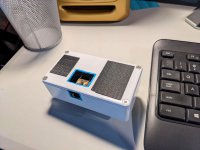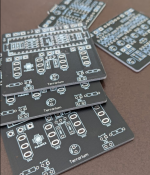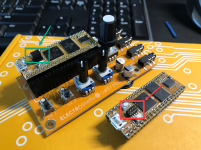Here's the petal reverb example ported over to terrarium.
I'm guessing that the pots are hooked up the same as the petal (I'm pretty sure that I guessed wrong - will update the code).
It sounds like a reverb. I haven't played with it much. Just played about 5 minutes.
So the Terrarium pots map to petal knobs, as follows:
Pot1 -> Knob1
Pot2 -> Knob3
Pot3 -> Knob5
Pot4 -> Knob2
Pot5 -> Knob4
Pot6 -> Knob6
So the Reverb controls are as follows:
Pot1: Reverb Time (Small room to near infinite)
Pot2 Reverb Damping (Internal Cuoff filter from about 500Hz to 20 Khz)
Pot3: Send Amount (Controls amount of dry signal)
The code has been updated to work, correctly.
I'm guessing that the pots are hooked up the same as the petal (I'm pretty sure that I guessed wrong - will update the code).
It sounds like a reverb. I haven't played with it much. Just played about 5 minutes.
So the Terrarium pots map to petal knobs, as follows:
Pot1 -> Knob1
Pot2 -> Knob3
Pot3 -> Knob5
Pot4 -> Knob2
Pot5 -> Knob4
Pot6 -> Knob6
So the Reverb controls are as follows:
Pot1: Reverb Time (Small room to near infinite)
Pot2 Reverb Damping (Internal Cuoff filter from about 500Hz to 20 Khz)
Pot3: Send Amount (Controls amount of dry signal)
The code has been updated to work, correctly.
C++:
#include "daisy_petal.h"
#include "daisysp.h"
#include "terrarium.h"
using namespace daisy;
using namespace daisysp;
using namespace terrarium;
// Declare a local daisy_petal for hardware access
DaisyPetal hw;
dsy_gpio led1;
Parameter vtime, vfreq, vsend;
bool bypass;
ReverbSc verb;
// This runs at a fixed rate, to prepare audio samples
void callback(float *in, float *out, size_t size)
{
float dryl, dryr, wetl, wetr, sendl, sendr;
hw.DebounceControls();
verb.SetFeedback(vtime.Process());
verb.SetLpFreq(vfreq.Process());
vsend.Process(); // Process Send to use later
if (hw.switches[Terrarium::FOOTSWITCH_1].RisingEdge())
bypass = !bypass;
for (size_t i = 0; i < size; i+=2)
{
dryl = in[i];
dryr = in[i+1];
sendl = dryl * vsend.Value();
sendr = dryr * vsend.Value();
verb.Process(sendl, sendr, &wetl, &wetr);
if (bypass)
{
out[i] = in[i]; // left
out[i+1] = in[i+1]; // right
}
else
{
out[i] = dryl + wetl;
out[i+1] = dryr + wetr;
}
}
}
int main(void)
{
float samplerate;
hw.Init();
samplerate = hw.AudioSampleRate();
vtime.Init(hw.knob[hw.KNOB_1], 0.6f, 0.999f, Parameter::LOGARITHMIC);
vfreq.Init(hw.knob[hw.KNOB_4], 500.0f, 20000.0f, Parameter::LOGARITHMIC);
vsend.Init(hw.knob[hw.KNOB_2], 0.0f, 1.0f, Parameter::LINEAR);
verb.Init(samplerate);
hw.StartAdc();
hw.StartAudio(callback);
led1.pin = hw.seed.GetPin(22);
led1.mode = DSY_GPIO_MODE_OUTPUT_PP;
led1.pull = DSY_GPIO_NOPULL;
dsy_gpio_init(&led1);
bypass = false;
while(1)
{
// Do Stuff InfInitely Here
dsy_system_delay(10);
dsy_gpio_write(&led1, bypass ? 0 : 1);
}
}
Last edited:



